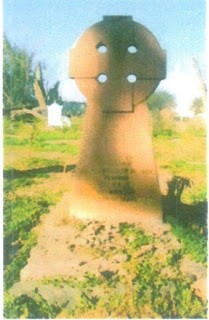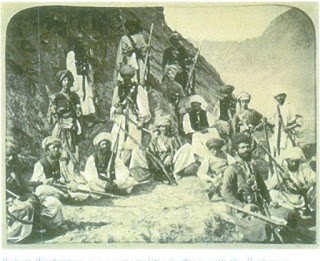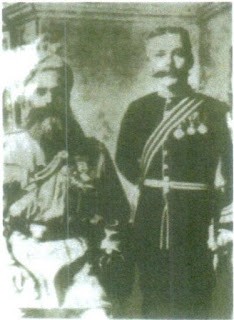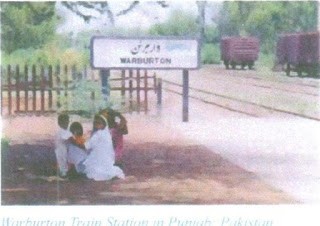From Dr Hamid Hussain (received as PDF and converted, kindly excuse any formatting issues)
AN ANGLO–AFG HAN– IND IAN DYNASTY
THE STORY OF THE WARBURTONS
Hamid Hussain
The story of the Warburtons began with a love affair in the middle of a war, that spanned two cultures and led to the founding of a distinguished and flamboyant dynasty spanning several generations.
Robert Warburton, the founder of this extraordinary family, was born 8 March in Garryhinch , Ireland . He joined the Bengal Artillery in 1831 , was commissioned in the 6th Regiment of that distinguished formation, later moving to the 5th Regiment. The Warburton’s story begins with the First Afghan War of 1839-42. When the deposed Afghan ruler Shah Shuja recovered his throne with British and Indian bayonets, Warburton raised and commanded the ‘ King’s Own Artillery ‘ in the shah’s army.
Once the British were ensconced in Kabul, Warburton met and fell in love with Shah Jahan Begum. Shah Jahan Begum, who was born in 1813, was the daughter of Adul Rahim Khan, a Popalzai Durrani noble. She was married to Sardar Faiz Talab Khan. Who served at the court of Amir Dost Muhammad Khan, and they had a son in 1840. Later that year, she fell in love with Warburton, and after securing divorce, she married the English officer in November 1840 . The couple was married according to Muslim law; the ceremony was conducted by Qazi Fatehullah. The Mahar, a dowry promise d by the groom, was the astounding sum of 600,000 Rupees. Guests at the marriage included Sir Alexander Burnes, Lt. John Leigh Stuart and Lt. Charles Howard Jenkins. Three Muslim officers, Subedars Abdullah Khan, Mir Haji and Sirdar Khan, signed as witnesses to the union.
The young couple had little time to enjoy their new happiness. The British position in Afghanistan began to deteriorate, and the army was driven from Kabul and destroyed as it struggled southwards. Warburton was handed over as hostage to one of the Afghan insurgent leaders, Mohammad Akbar Khan, in December 1841 along with five other officers: Capts. Airey, Conolly, Drummond, Walsh and Webb.
Warburton along with a number of other English hostages was sent north to Bamian when an East India Company relief force retook Kabul. Saleh Muhammad Khan commanded the force detailed to escort the prisoners to Bamian. Saleh had an exciting career. He was Subedar of the 6th Regiment of Shah Shuja’s infantry, which had been commanded by Captain Perin Hopkins, who was killed in Jalalabad in January 1842. When the British were driven from Kabul, Saleh Muhammad deserted with his company to Dost Muhammad. A short time later an English prisoner, George Lawrence (brother of Henry and John), called Muhammad by his name and old rank. Saleh Muhammad replied: “Lawrence Sahib, I am a general now, so you must now style me “General'”.
As the returning EIC forces drove back the Afghans, Saleh Muhammad again switched sides when his English prisoners made an offer he could not refuse. He was guarantee a pension for life of a thousand rupees a month with an additional 20,000 rupees to be paid as soon as the prisoners reached Kabul. The next morning, Saleh Muhammad raised a ‘flag of defiance’ above the fort announcing his revolt against Akbar Khan. It was perfectly in line with Afghan tradition. The freed English officers promptly set up a new governor of Bamian district, and two Hazara chiefs tendered their allegiance to the new administration. But the British withdrew from Afghanistan shortly thereafter and Dost Muhammad Khan returned to power’.

Robert Warburton returned to India after his release. He was commanding the 19th brigade of the Royal Artillery at Peshawar where he died in November 1863 at the age of 51. He is buried at the Christian cemetery near Tehkal Bala in Peshawar.
Saleh Muhammad followed the British to India, and settled in Ludhiana. a city that had become a favoured refuge for Afghans lucky enough to keep their heads after losing in one or other of the bloody power games on the chessboard of Afghan politics. In 1857, he raised and commanded a mounted contingent to aid the British when their rule was challenged by the revolt of the Bengal army. The force consisted of some 130 Afghans, Punjabi Muslim and Sikhs. It was later incorporated into Skinner’s Horse, and his brother Fateh Muhammad was appointed Risaldar.
Warburton and his Afghan bride had a son who was also named Robert. He was born in a Ghilzai fort between Jagdullak and Gandamak when his mother was on the run from Afghan insurgents after the British retreated from Kabul. A number of Afghan women had married British officers. and they were a special target for the insurgents. In one case, an eighteen year old Afghan girl who had married a British officer was burned alive and the throats of all her servants were slit. Shah Jahan Begum was sheltered by relatives and well-wishers in various
towns, villages and hamlets. Finally, she escaped in disguise and reached
Peshawar in 1843, where she was joined by her two sons.
towns, villages and hamlets. Finally, she escaped in disguise and reached
Peshawar in 1843, where she was joined by her two sons.
Robert’s early education was at a school in Mussoorrie before he was sent to England and entered Kensington Grammar school. He attended Woolwich and was commissioned in the Royal Artillery in December 1861. He served with F Battery of the 19th Artillery Brigade, which his father had commanded. He also served with the 21st Punjab Infantry in the Abyssinia campaign in 1868 and the 15 Ludhiana Sikhs before transferring to the Political Department.
He was Assistant Commissioner of Peshawar and Mardan before being appointed Political Officer of the Khyber in 1879. During the Second Afghan War, Warburton serve as political officer of the Jalalabad Valley Field Force. He was fluent in Pushtu and Persian and his linguistic skills and Afghan heritage gave him a special status when dealing with tribesmen.
The Khyber Jazailchis were raised byCapt. Gilbert Gaisford in 1878 as a paramilitary force to police the famous pass. Warburton later took over the force. His right hand man was the legendary
Honorary Colonel Muhammad Aslam Khan. Aslam was from the royal Saddozai family of Afghanistan. He started his career as risaldar with the 5th Bengal Cavalry in the I857 mutiny.
The two men transformed the force into the famous Khyber Rifles. Regular troops were withdrawn, and the Khyber Rifles became the guardians of the pass. Under its watchful eye, law and order in large swathes around the Khyber was far superior to that in many settled areas. When Warburton left his post on May I0, 1897 due to ill-health, hundreds of Afridis crowded the platform of Peshawar railway station to say goodbye to a man they regarded as a friend. In the autumn of 1897, there was a general uprising among the Khyber tribes, and Warburton was recalled. He had complete faith in the Afridis and traveled around the Khyber accompanied by just four orderlies of the Khyber Rifles.
When British forces entered the Afridi heartland in the Tirah, and burned the tribesmen’s homes as retribution, Warburton told a group of old Afridis that it was beyond his power to prevent the destruction. With tears in their eyes, the grey beards of the Afridi jirga or council replied. “Never mind, Sahib, whatever happens we are earnestly praying that you may not be injured in this campaign Warburton died in England and is buried in Brompton Cemetery in London.
Robert Warburton ‘s daughter, Marie, married Lt. Col. James Richard Birch of the Cheshire Regiment. Their son, Lt. Col. James Robert Birch joined his father’s regiment. In 1933, thirty-five years after Warburton’s retirement, a huge crowd of Afridis showed up at Landi Kotal railway station just before the arrival of a troop train carrying the Ist Battalion of the Cheshire Regiment. The tribesmen had heard that Warburton’s grandson was an officer in the battalion and had come to see him.
The famous exploits of Robert Warburton on the North West Frontier were matched by the career of his Afghan step-brother. Shah Jahan Begum’s son by her first marriage, Jahan Dad Khan, was adopted by the first Robert Warburton. The boy was baptized John Paul Warburton, and educated at the Roman Catholic school at Agra. He joined the Punjab Police in 1864, and during a long career served at Kamal, Ludhiana, Muzzaffargarh and Ambala, eventually retiring as Deputy Inspector General (DIG) of Railway Police. After leaving British service, he served as Inspector General of Patiala State Police.
John Warburton became a legend for his remarkable detective work and relentless pursuit of robbers. Locals, struggling with pronouncing his name, called him “Button Sahib’. He was given many difficult cases because he spoke Pushtu and Persian and possessed an innate understanding of local attitudes and customs. In one case, a band of Pathan thieves repeatedly evaded capture. The case was assigned to ‘Button Sahib’ and he arrested most the gang members and broke up the ring.
Like his step-father, John Warburton was smitten by love in unusual circumstances. ln 1863, while out exercising one morning, he saw a young woman being attacked by a mad dog. He intervened and rescued her. The woman was Mary Meakins. a beautiful 21-year-old widow with three children She had married Ensign William Philip Meakins at the age of fourteen. Meakins had died of cholera, and Mary was Iiving with her parents. John married Mary at Ludhiana, where he lived with his mother, who was attended by her own retinue of Afghan servants. The Afghan widow was proud of her royal lineage, and made sure that everybody understood her station.
In later years, John was allotted land near Lahore for his services, and the town that grew up in the area was named Warburton. He built a house and a garden there. Later, a railway station was constructed for the town bearing the name Warburton. After retirement, he lived at Gilbert House in the hill station of Kasauli. He was out riding in October 1919 when he fell from his horse; a broken rib punctured his lung and he later died. Edmund Candler wrote an obituary hailing the former police man, saying: ·’he went through life with a brave heart and clean hands”.
John had two sons (Robert and Arthur, and four daughters (Durani, Lizzie, Minna and Muriel). His son Arthur served with the Burma Police. His grandson Julian Durani Warbrton ( 1894-1936) a!so joined the Punjab PoIice, where he had a distinguished career, winning the King’s Police medal and the OBE. He died at the young age of 41 . His wife Lucy Farrant joined the Intelligence Bureau as a cipher officer.
The Warburtons, with their Anglo-Indian heritage. illustrate how the barriers of race could sometimes be overcome in British India. Few Anglo-Indian families achieved so much.
* * *
Further reading:
Colonel Sir Robert
Warburton. Eighteen years in Khyber 1879-1898 (Lahore: Sang-e- meel
Publications 2007, Reprint of 1900 Edition)
Warburton. Eighteen years in Khyber 1879-1898 (Lahore: Sang-e- meel
Publications 2007, Reprint of 1900 Edition)
G. D. Martineau. Controller
of Devils: A
Life of John Paul Warburton. C.J.E. of The Punjab Police (Privately Published)
of Devils: A
Life of John Paul Warburton. C.J.E. of The Punjab Police (Privately Published)
Hamid Hussain.
The Romance of Soldiering – Experience
of Colonial India. Defence
The Romance of Soldiering – Experience
of Colonial India. Defence
Journal, October 2002
Wing Commander® Sardar Ahmad Shah Jan
Saddozai. Saddozai: Saddozai
Kings & Vaziers
Saddozai. Saddozai: Saddozai
Kings & Vaziers
of Afghanistan (Peshawar: Public
Arts Press), 2007
Arts Press), 2007




This is a very well written and concise account of the Warburton family , a name I chanced upon in David Gillmore’s “ The Ruling Caste”.
A fascinating story of a mixed marriage that started a dynasty of good men and true in the best British tradition. Men who through the generations showed their love for India .